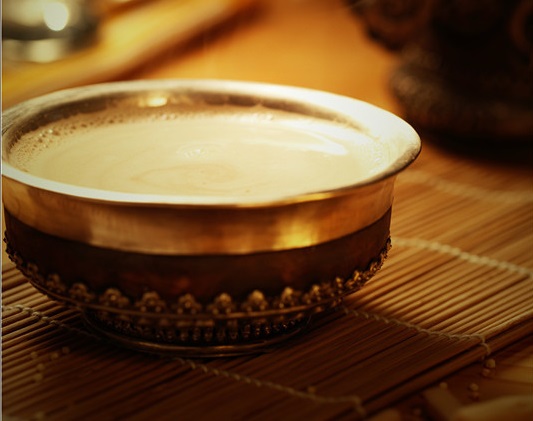Introduction: The Importance of Tea in Mongolian Culture
Tea is an essential part of Mongolian culture and hospitality. Known as suutei tsai, Mongolian tea is a hot beverage that is served throughout the day, especially during meal times. It is believed that drinking tea helps to warm the body and aids digestion, making it a staple in the Mongolian diet. Mongolians also consider tea as a symbol of hospitality and friendship, where it is customary to offer guests a cup of tea as a sign of respect and affection.
The Ingredients: What Goes into Mongolian Tea?
Mongolian tea is made from a combination of tea leaves, water, salt, and milk. The tea leaves used in Mongolian tea are typically a blend of green and black tea leaves, which are boiled in water for several minutes. Salt is added to bring out the flavor of the tea and to balance the sweetness of the milk. Milk is also added to the tea, giving it a creamy texture and a unique flavor. Mongolians sometimes add other ingredients to their tea, such as butter, barley, or even animal fat, depending on the region and the household’s preferences.
The Equipment: Traditional Tea Preparation Tools
Mongolian tea is traditionally prepared using a set of special tools. The first tool is a small pot called a suudal, which is used to boil the water and tea leaves. The second tool is a wooden spoon called a shugar, which is used to stir the tea and to add the salt and milk. The third tool is a small bowl called a zagaa, which is used to serve the tea. The zagaa is typically made of wood, metal, or ceramic and is decorated with intricate designs and patterns.
Step-by-Step: How to Prepare Mongolian Tea
To prepare Mongolian tea, fill the suudal with water and bring it to a boil. Add the tea leaves and let it simmer for several minutes until the water turns a dark brown color. Using the shugar, stir the tea and add the salt and milk. Continue to stir until the ingredients are well combined. Once the tea is ready, pour it into the zagaa and serve. Mongolians typically drink their tea hot, but it can also be enjoyed cold during the summer months.
The Art of Pouring and Serving Mongolian Tea
Pouring and serving Mongolian tea is an important part of the tea-drinking experience. The person serving the tea usually holds the zagaa with both hands and offers it to the guest as a sign of respect. The guest then takes the bowl with both hands and takes a sip of the tea. Mongolians usually drink their tea slowly, savoring the flavor and enjoying the company of their guests. Once the tea is finished, the guest returns the zagaa to the server as a sign of gratitude.
Conclusion: Drinking Tea as a Symbol of Hospitality and Friendship
Mongolians take pride in their tea culture, where drinking tea is seen as a symbol of hospitality and friendship. Mongolian tea is a unique and flavorful beverage that is enjoyed by people of all ages. The traditional tools and techniques used to prepare and serve Mongolian tea have been passed down from generation to generation, making it an integral part of Mongolian heritage. Whether you are visiting a Mongolian household or dining in a local restaurant, be sure to try a cup of suutei tsai and experience the warmth and hospitality that Mongolians are known for.

